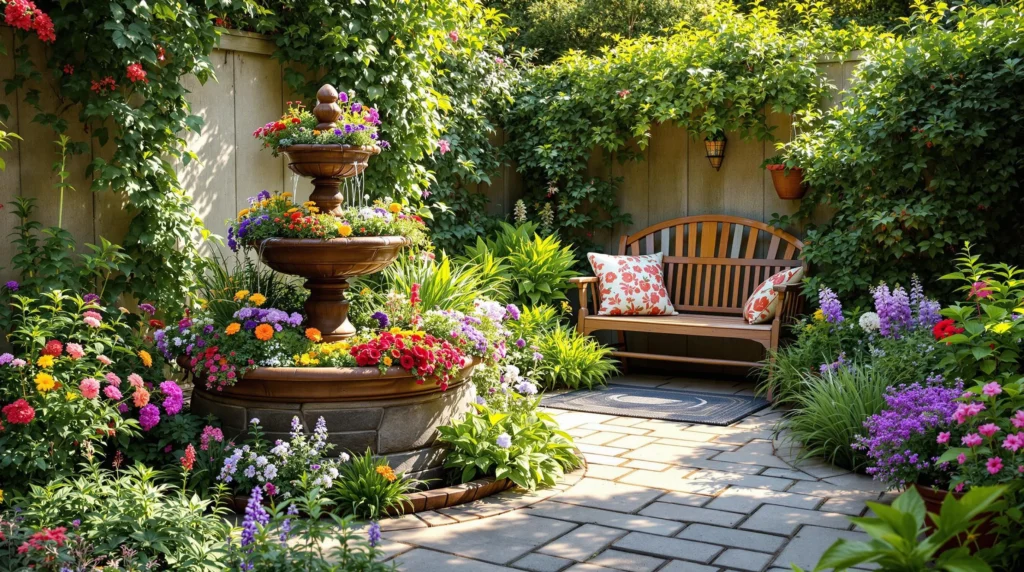10 Creative Corner Garden Ideas for Maximizing Unused Space
1. Tiered Corner Planters
Maximize vertical space with tiered corner planters that create visual interest while accommodating multiple plants in a compact area. These stepped designs naturally fit into corners and allow you to showcase a variety of flowers, herbs, or small vegetables. Consider using materials that complement your home’s exterior, such as wooden crates, metal stands, or concrete blocks for a modern look.
2. Corner Water Features
Transform your garden corner into a tranquil retreat by installing a small fountain or waterfall. Corner water features create a peaceful atmosphere while masking unwanted noise from streets or neighbors. Choose compact designs specifically made for corners, which often include built-in planters for additional greenery around the water element.
3. Corner Seating Nook
Create an intimate garden retreat by placing a bench or small seating arrangement in your corner space. This design works especially well when you add overhead structures like pergolas or trellises to provide shade and privacy. Add outdoor cushions, small side tables, and string lights to make this corner feel like a cozy outdoor living room.
4. Vertical Corner Garden
Use the vertical dimension by installing wall planters, hanging baskets, or trellises in your garden corner. This approach is perfect for small spaces where ground area is limited. Try pocket planters, repurposed pallets, or specialized vertical garden systems to grow everything from succulents to herbs and flowering vines.
5. Corner Rock Garden
Design a low-maintenance corner garden using rocks, gravel, and drought-resistant plants. This style works particularly well in awkward corners that receive minimal attention. Incorporate various rock sizes and colors, then plant succulents, sedums, and ornamental grasses that thrive in well-drained soil with minimal care requirements.
6. Corner Fire Pit Area
Install a fire pit in your garden corner to create a gathering spot that naturally draws people together. The corner location helps define the space while providing two solid barriers that enhance privacy and reflect heat. Surround your fire pit with weather-resistant seating and plant fire-resistant vegetation nearby for safety and aesthetic appeal.
7. Corner Herb Spiral
Build a spiral-shaped raised bed that maximizes growing space while creating different microclimates for various herbs. This clever design fits perfectly into corners and allows you to grow sun-loving herbs like rosemary and thyme at the top, with shade-tolerant varieties like mint and parsley lower down where moisture retention is higher.
8. Corner Wildlife Habitat
Dedicate your garden corner to supporting local wildlife by creating a mini-network. Install bird feeders, bird baths, insect hotels, and native plants that provide food and shelter for pollinators. The sheltered nature of corners makes them ideal locations for wildlife to feel protected while visiting your garden.
9. Corner Meditation Space
Design a peaceful retreat in your garden corner with minimalist elements focused on tranquility. Place a comfortable meditation cushion or small bench on a bed of smooth pebbles or sand. Surround the area with simple, low-maintenance plants like bamboo or ornamental grasses that create gentle sounds when the wind blows.
10. Corner Trellis Archway
Install a corner trellis that creates an archway leading to another section of your garden. This architectural element adds height and serves as a support for climbing plants like roses, clematis, or jasmine. The corner placement creates a natural transition point while turning an unused space into a stunning garden feature that frames views and invites exploration.
Transforming Awkward Angles: Understanding Corner Garden Potential
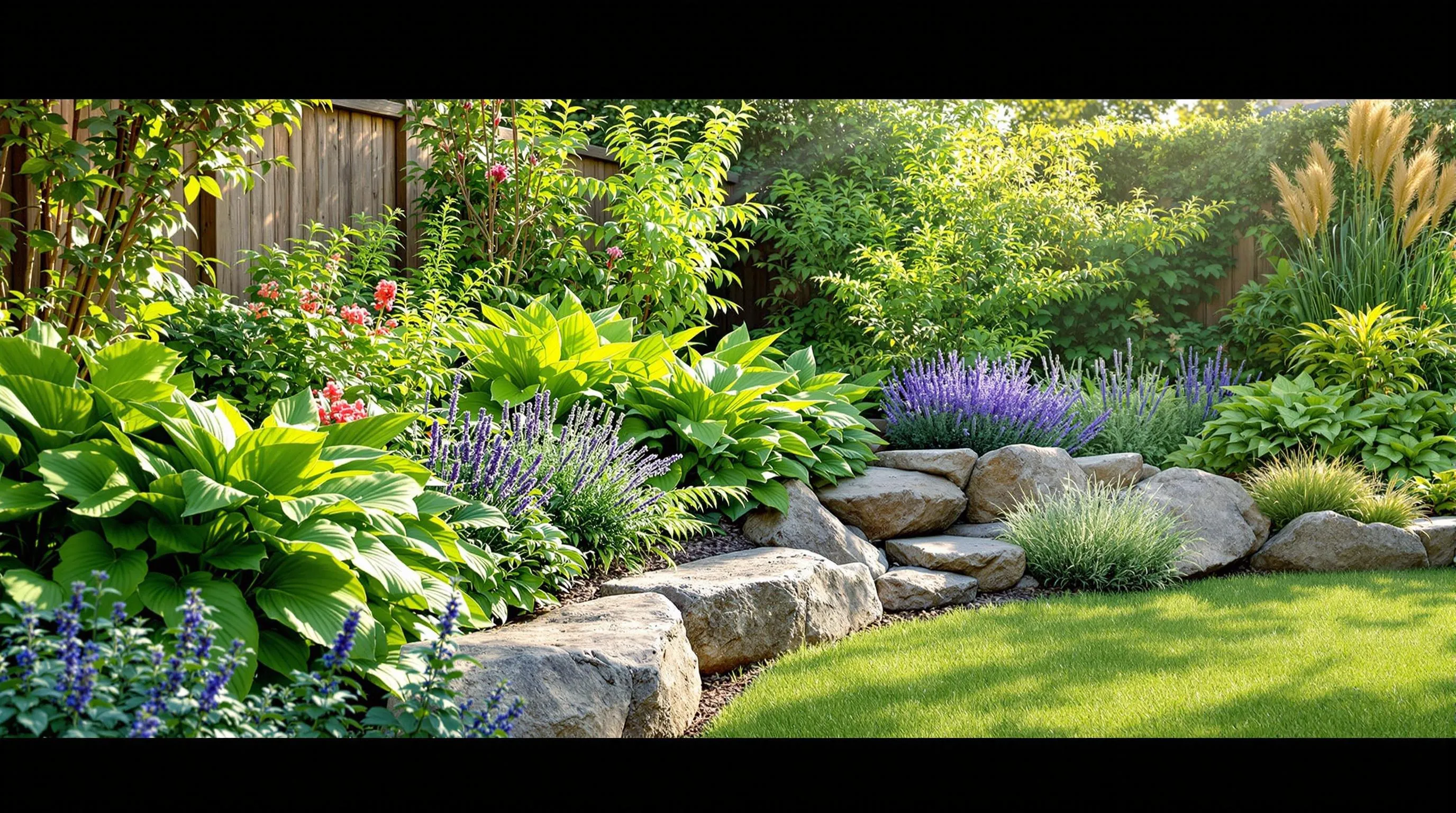
Corner spaces in gardens often present unique challenges but also offer incredible opportunities for creative landscaping. These awkward angles might seem difficult to work with initially, but with the right approach, they can become standout features in your outdoor space.
Assessing Your Corner Space
Before diving into your corner garden project, take time to properly assess what you’re working with. Measure the dimensions of your corner area, noting both the available ground space and vertical potential. Check for any existing structures or utilities that might impact your design, such as drainage pipes, utility boxes, or overhanging trees. Consider the soil quality—corners often collect debris and may have compacted or poor-quality soil that needs amendment. Also examine traffic patterns around the corner to ensure your design won’t obstruct natural movement through the garden. Taking photos from multiple angles can help you visualize possibilities and share ideas with landscapers or garden center staff. A thorough assessment will help you identify limitations and opportunities unique to your corner space.
Working With Light Conditions in Corners
Corner spaces typically receive different light exposure than the rest of your garden, creating both challenges and opportunities. North-facing corners may remain shaded for most of the day, making them perfect for shade-loving plants like hostas, ferns, and astilbe. East-facing corners receive gentle morning sunlight, ideal for plants that appreciate sun protection during hot afternoons. South and west-facing corners often get the most intense sun exposure, making them excellent for sun-loving plants like lavender, salvias, and ornamental grasses. Monitor your corner throughout different seasons to understand how light patterns change. Consider using shade-tolerant plants at the deepest part of the corner where light penetration is minimal, gradually transitioning to more sun-loving varieties as you move outward. This strategic plant placement transforms light limitations into opportunities for creating ever-changing, multi-layered garden displays.
Vertical Corner Gardens: Growing Up Instead of Out
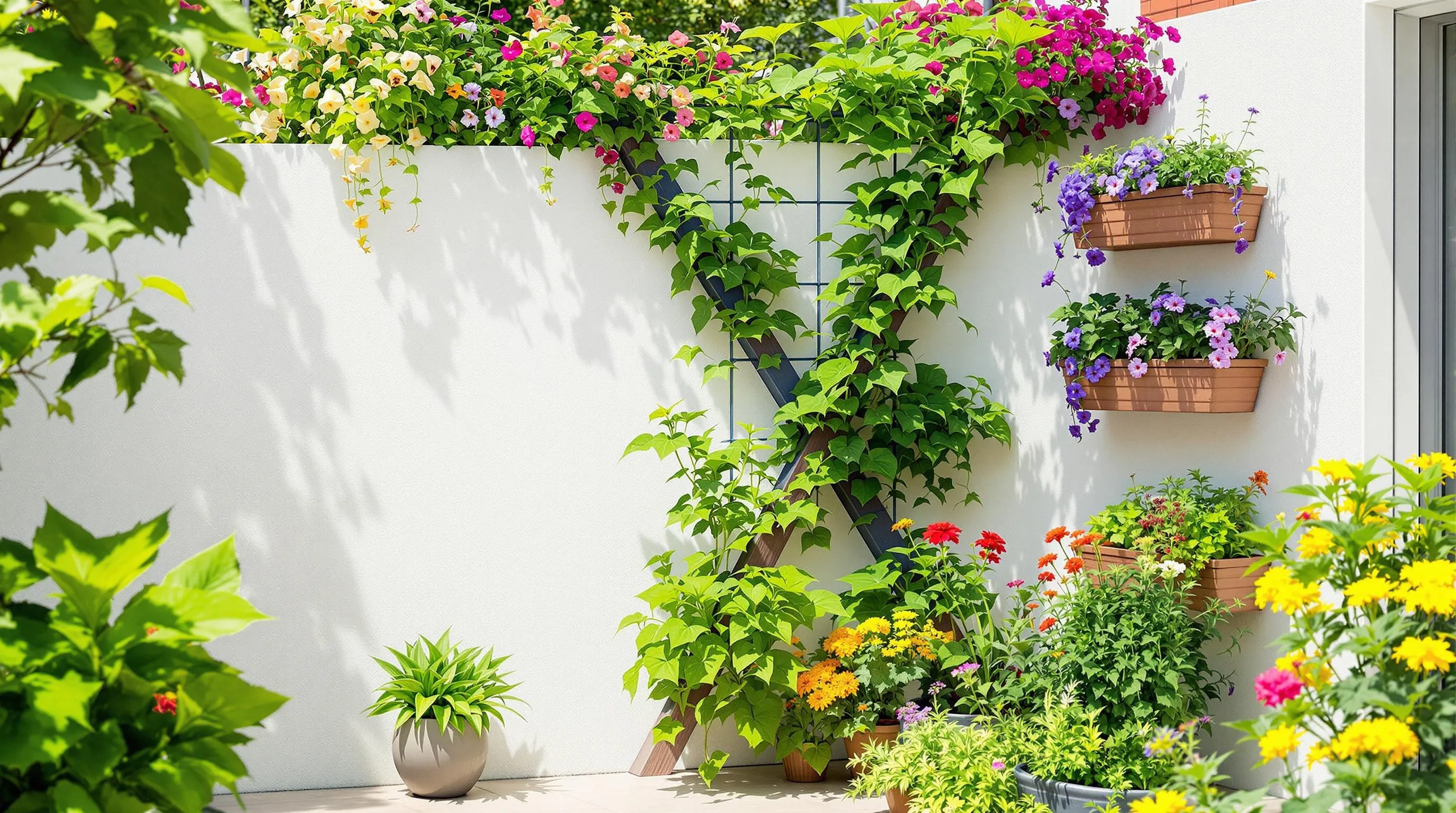
When horizontal space is limited, going vertical in your corner garden offers an excellent solution. Vertical gardening transforms awkward corners into lush, productive growing areas while adding architectural interest to your outdoor space. By utilizing walls, fences, and vertical structures, you can maximize your growing capacity without expanding your garden’s footprint.
Trellises and Wall-Mounted Planters
Trellises are perfect for corner installations, creating a dramatic visual effect while supporting climbing plants. Install a V-shaped trellis system in your corner to double your growing surface, ideal for vining vegetables like cucumbers, beans, and peas, or flowering climbers such as clematis and morning glories. Wall-mounted planters offer another space-efficient option for corner gardens. Attach tiered hanging planters to walls that meet in corners, or install pocket planters in a cascading pattern. These systems work wonderfully for herbs, small flowering plants, and even strawberries. For a modern look, try geometric wall planters arranged in an asymmetrical pattern, which adds visual interest while providing homes for small succulents and air plants.
Corner Garden Towers and Tiered Systems
Corner garden towers make excellent use of vertical space while fitting perfectly into angular areas. These multi-level structures can host dozens of plants in a compact footprint. Commercial options include spiral planters, corner pyramid systems, and triangular vertical gardens specifically designed for corners. You can also DIY your own corner tower using stacked containers of decreasing size, creating a visually appealing plant display. For small spaces, consider a corner plant stand with multiple shelves where you can arrange potted plants at different heights. These tiered systems allow you to grow a variety of plants while showcasing them in an organized, visually striking way. For edible gardens, vertical corner towers with integrated irrigation systems offer an efficient way to grow herbs, lettuce, and strawberries in minimal space.
Curved Corner Garden Beds: Softening Sharp Angles
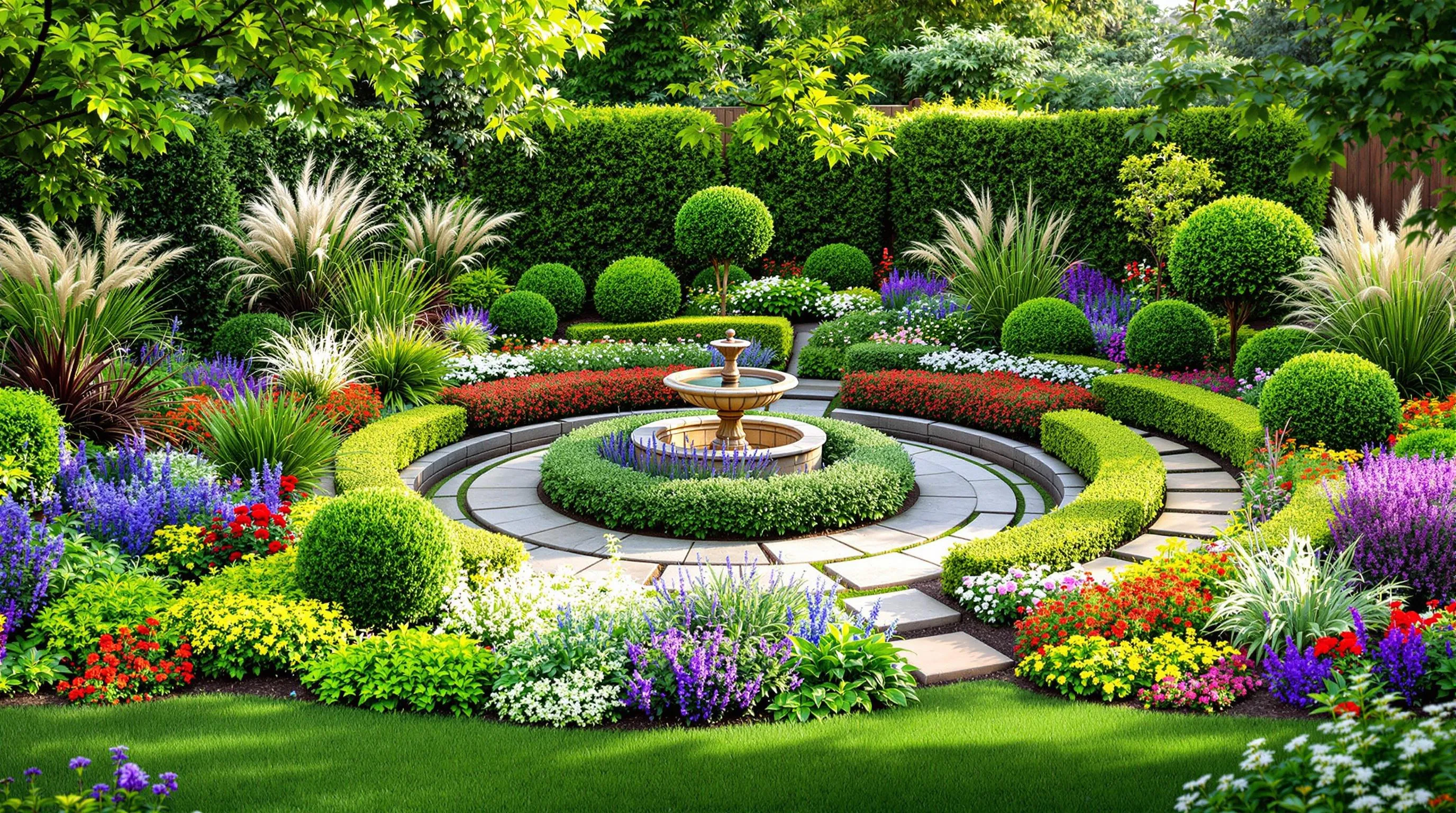
Transform rigid corner spaces with curved garden beds that create a more natural, flowing aesthetic in your outdoor space. These rounded designs not only soften harsh angles but also create a sense of movement and organic beauty that straight-edged beds simply can’t match.
Designing With Circular Patterns
Curved corner beds work best when you incorporate circular design elements that echo their shape. Start with a gentle arc that follows your corner’s natural flow, creating a rounded edge that contrasts with your yard’s straight lines. Layer plants in concentric circles, with taller specimens toward the back of the corner and gradually shorter ones as you move outward. Consider adding curved pathways made of stepping stones, crushed gravel, or brick pavers that lead the eye through your corner garden. Round elements like a circular birdbath, gazing ball, or curved bench can serve as focal points that reinforce the curved theme while providing practical functionality.
Plants That Complement Curved Spaces
Choose plants with rounded forms and flowing habits that naturally enhance curved garden beds. Ornamental grasses like fountain grass (Pennisetum) or Japanese forest grass (Hakonechloa) create movement with their arching habits. Round-shaped shrubs such as boxwood, lavender, and hydrangeas provide structure while maintaining the curved aesthetic. For groundcover, consider creeping plants that will cascade over edges, like creeping thyme, sweet alyssum, or wave petunias. Incorporate plants with circular flowers or leaves—think hostas, coral bells, or black-eyed Susans—to reinforce the rounded theme. Mix in plants with different heights, textures, and blooming periods to create visual interest throughout the seasons while maintaining the soft, flowing lines of your curved corner garden.
Corner Water Features: Adding Tranquility to Tight Spots
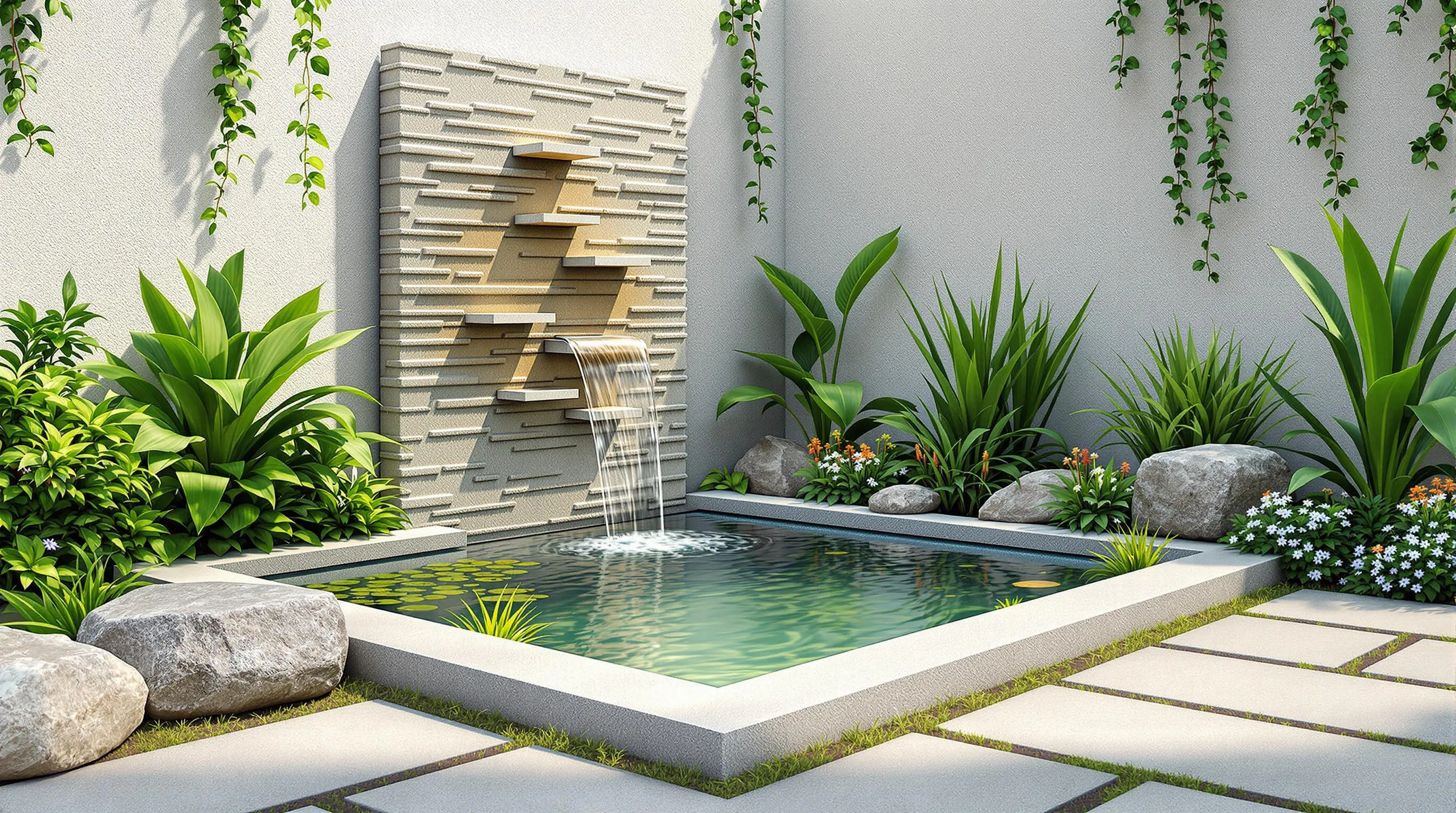
Transform those awkward garden corners into peaceful retreats with the soothing sounds of water. Corner water features maximize limited space while creating a calming focal point that enhances your entire garden atmosphere.
Space-Saving Fountain Ideas
Wall-mounted fountains offer the perfect solution for tight corners, requiring minimal floor space while providing maximum visual impact. Install a slim copper or stone waterfall fountain that channels water down textured surfaces for a mesmerizing effect. Tiered corner fountains work brilliantly in 90-degree angles, with water cascading from level to level before recycling through a hidden pump system. For ultra-compact spaces, consider tabletop fountains placed on corner pedestals or solar-powered options that eliminate the need for electrical outlets. Bamboo spout fountains can be positioned diagonally across corners, creating an Asian-inspired aesthetic while occupying minimal square footage.
Corner Pond Designs
Corner ponds maximize awkward spaces by following the natural boundaries of your garden. Create a triangular pond that fits snugly into a corner, using pre-formed liners designed specifically for corner installations. Enhance your corner pond with marginal plants like dwarf cattails or Japanese iris that thrive in shallow water edges. For depth perception, position larger water plants toward the back of the corner and smaller varieties toward the front. Incorporate flat stones around the edges that double as seating spots where you can dangle your feet on hot summer days. Small corner ponds can still support aquatic life—consider adding a few goldfish or native minnows that require minimal maintenance and help control mosquito larvae.
Diagonal Corner Planting: Strategic Placement Techniques
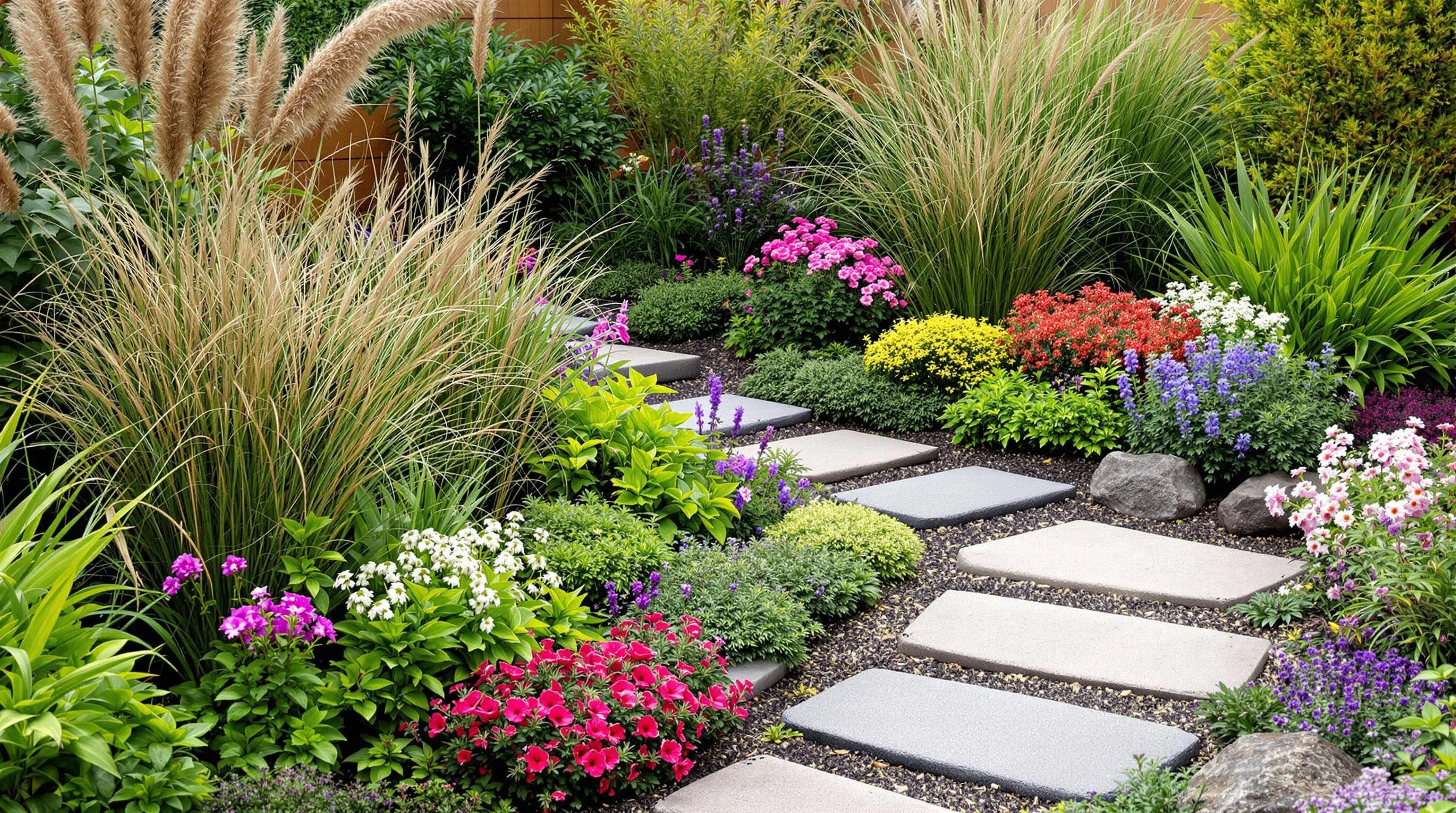
Diagonal planting transforms awkward corners into ever-changing garden spaces by using strategic angles rather than traditional parallel rows. This approach maximizes space while creating visual interest in often-neglected areas of your garden.
Creating Depth With Layered Plantings
Layering plants diagonally creates an illusion of depth that makes your corner garden appear larger and more sophisticated. Start with taller plants like ornamental grasses or slender evergreens at the corner’s deepest point, then gradually decrease plant height as you move outward. Place mid-height plants like flowering perennials in the middle layer, and finish with ground covers or low-growing flowers at the edges. This triangular arrangement draws the eye from the narrowest point outward, making the corner feel intentional rather than leftover. For maximum impact, incorporate plants with varied textures and complementary colors that bloom in different seasons, ensuring your corner garden remains visually interesting year-round.
Visual Tricks to Expand Corner Spaces
Strategic diagonal placement creates the illusion of a larger space in tight corners. Position your tallest plants at a 45-degree angle from each corner wall rather than directly in the corner itself. This diagonal line draws the eye across the space diagonally, making it appear wider than it actually is. Use repeating patterns of the same plant species along these diagonal lines to create rhythm and flow. Incorporate mirrors or reflective ornaments positioned to capture and reflect light and plants, instantly doubling the perceived size of your corner garden. Adding a small, diagonal pathway of stepping stones or gravel cutting through the corner planting creates depth while improving accessibility for maintenance. These visual tricks transform cramped corners into spacious-feeling garden features that seamlessly integrate with the rest of your industry.
Small Corner Seating Areas: Creating Garden Retreats

Even the smallest garden corner can be transformed into a cozy retreat where you can relax and enjoy your outdoor space. Corner seating areas maximize efficiency while creating intimate spaces that invite you to linger and appreciate your garden from a new perspective.
Built-In Corner Benches
Built-in corner benches offer the perfect solution for awkward garden corners, providing both functionality and style. These space-saving seating options fit snugly against walls or fences, making use of every inch of available space. Consider L-shaped designs that follow your garden’s contours for maximum seating capacity. For added versatility, incorporate storage underneath the bench seats to house garden tools, cushions, or outdoor games. Materials like cedar, redwood, or composite decking ensure durability against weather elements, while adding built-in planters at the ends creates a seamless transition to the surrounding garden. Enhance comfort with weather-resistant cushions and pillows in colors that complement your garden palette for a polished, inviting retreat.
Intimate Reading Nooks
Transform a forgotten corner into an intimate reading nook where you can escape with a good book surrounded by nature. Choose a comfortable, weather-resistant chair or small loveseat positioned to maximize both privacy and views of your garden. Create a sense of enclosure with tall ornamental grasses, climbing plants on trellises, or potted shrubs arranged in a semi-circle. Add a small side table for your beverages and reading materials, and consider installing subtle lighting options like solar lanterns or string lights for evening reading sessions. A small portable fire pit or outdoor heater can extend the usability of your reading nook into cooler seasons, making it a year-round retreat. The key is creating a space that feels separate and secluded while remaining connected to the beauty of your garden.
Corner Herb and Vegetable Gardens: Practical Planting
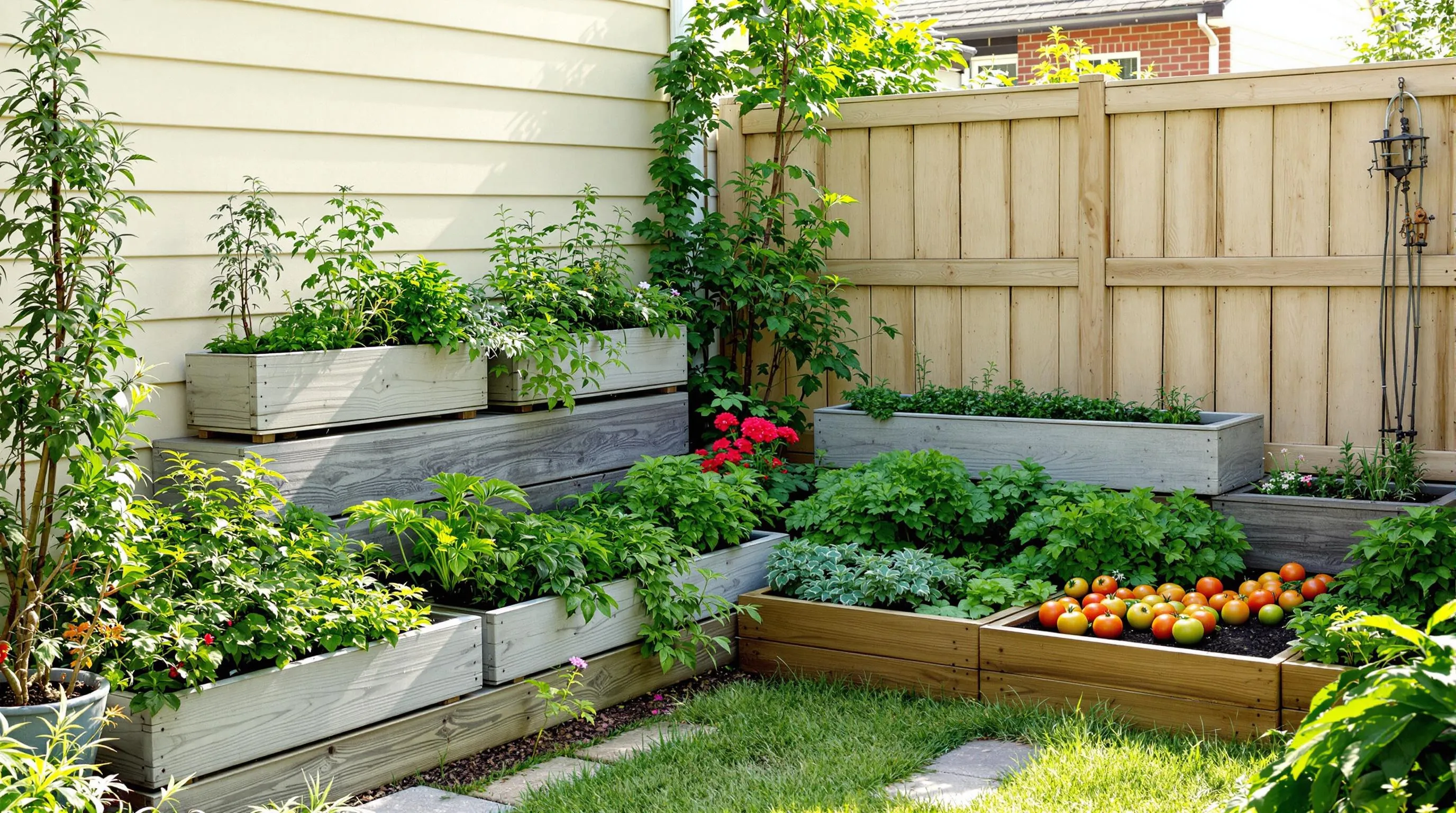
Transform those neglected corners into productive growing spaces with herb and vegetable gardens that combine beauty and functionality. Corner plots offer unique advantages for edible gardening, including protection from wind and concentrated sunlight in many cases.
Tiered Corner Herb Gardens
Tiered herb gardens maximize your corner space while creating visual appeal through vertical layering. Install stepped planters or repurpose wooden crates arranged in a pyramid formation to showcase your herb collection. Place sun-loving herbs like rosemary, thyme, and sage on the upper tiers where they’ll receive maximum light, while positioning shade-tolerant varieties such as mint and parsley on lower levels. This arrangement mimics natural growing conditions where different herbs thrive at various heights and light exposures. For added efficiency, incorporate drip irrigation systems that allow water to cascade from upper tiers down to lower plants, minimizing waste and ensuring consistent moisture throughout your herb garden.
Compact Vegetable Arrangements
Corner vegetable gardens thrive with strategic planting patterns that maximize limited space. Use triangular raised beds that fit snugly into corners, planting taller crops like tomatoes or pole beans at the deepest point and gradually stepping down to mid-sized plants like peppers, then compact varieties like lettuce and radishes at the front edges. Trellises installed at the back corner create vertical growing space for climbing vegetables such as cucumbers and peas without overshadowing other plants. For ultra-tight spots, try square foot gardening techniques with a triangular twist—divide your corner plot into small sections and plant each with a single vegetable variety based on its space requirements. This method prevents overcrowding while allowing you to grow an impressive variety of crops in your corner garden.
Corner Garden Lighting: Highlighting Neglected Spaces
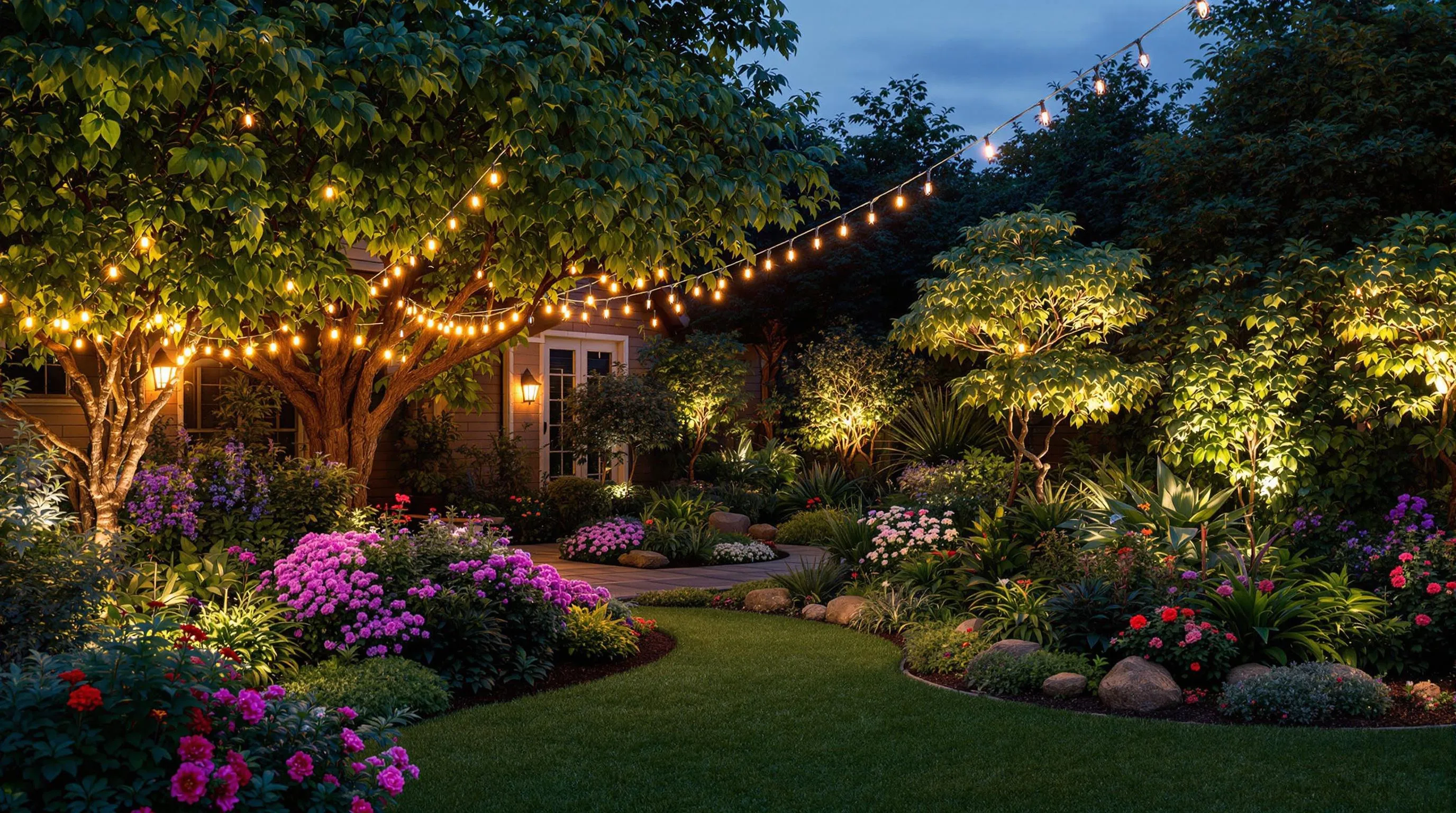
Proper lighting can transform forgotten garden corners into magical spaces that shine after sunset. Strategic illumination not only extends your garden’s usability into evening hours but also creates drama and depth in these often-overlooked areas.
Solar-Powered Corner Lighting Answers
Solar-powered lights offer the perfect solution for illuminating garden corners without the hassle of wiring or increased energy bills. Position solar stake lights along the perimeter of your corner garden to define its boundaries after dark. For vertical impact, install solar string lights that weave through trellises or hang from pergolas to create a starry canopy effect. Solar spotlights work wonderfully to highlight focal plants or garden sculptures, casting interesting shadows and creating depth. Consider solar-powered lanterns on hooks or shepherd’s crooks to add portable lighting that can be repositioned as needed. These eco-friendly options store energy during the day and automatically switch on at dusk, requiring minimal maintenance while providing sustainable illumination for your corner garden retreat.
Creating Evening Ambiance
Transform your corner garden into an enchanting nighttime destination by layering different light sources at varying heights. Install uplights at the base of ornamental grasses or sculptural plants to create dramatic shadows against walls or fences. Path lights with downward-facing beams guide movement while preventing light pollution. For intimate corner seating areas, suspend battery-operated pendant lights or lanterns from tree branches or structures to cast a warm glow at eye level. Consider color-changing LED lights to highlight water features or create mood lighting that can be adjusted seasonally. Flameless candles in weather-resistant holders add flickering ambiance to tabletops and steps without fire hazards. By thoughtfully combining these lighting elements, you’ll create a multi-dimensional nightscape that makes your corner garden feel expansive and inviting long after the sun sets.
Corner Garden Structures: Gazebos and Pergolas
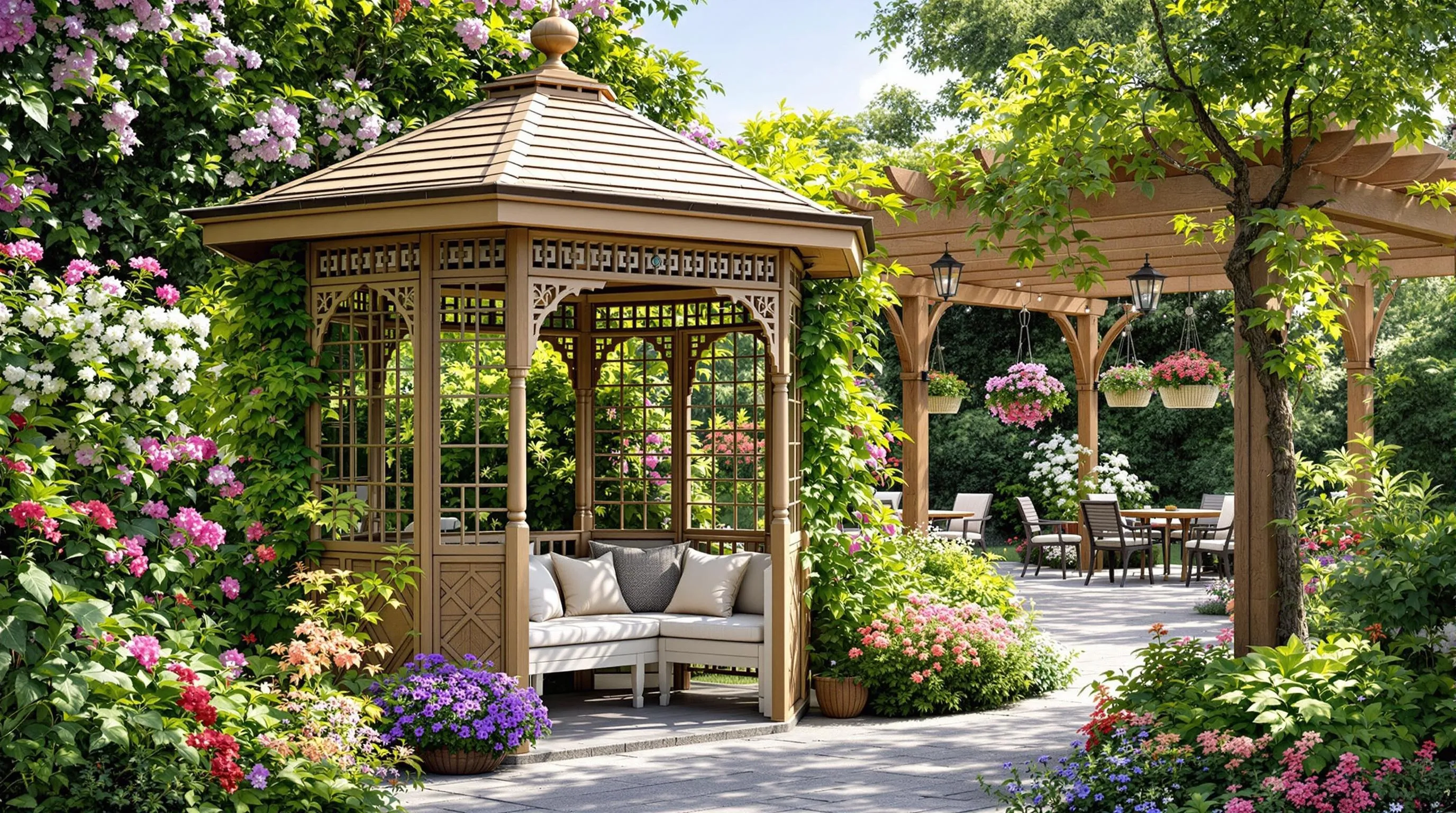
Mini Corner Gazebos
Mini corner gazebos transform overlooked garden angles into charming focal points while maximizing limited space. These compact structures fit snugly into 90-degree corners, creating instant architectural interest without overwhelming your garden’s footprint. You’ll find these scaled-down gazebos in various styles—from Victorian-inspired designs with ornate details to modern minimalist structures with clean lines. Many feature built-in benches that follow the angular walls, providing comfortable seating for 2-3 people. For tight spaces, consider hexagonal or octagonal corner gazebos that extend partially into the garden while anchoring the corner. Add climbing plants like jasmine or clematis around the supports to soften the structure and create a fragrant retreat. Weather-resistant materials such as cedar, redwood, or composite materials ensure your corner gazebo remains a lasting garden feature through changing seasons.
Angled Pergola Designs
Angled pergolas cleverly use corner spaces by creating dramatic diagonal lines that draw the eye and establish a sense of depth. Unlike traditional straight pergolas, these L-shaped or V-shaped structures follow your garden’s boundaries while creating a partially covered outdoor room. You’ll appreciate how angled pergolas provide multiple functions—defining pathways, supporting climbing plants, and creating dappled shade exactly where corner gardens typically receive harsh direct sunlight. Install bench seating along one or both sides to establish a cozy conversation area that embraces the corner’s intimacy. For added functionality, incorporate storage beneath built-in seating or attach hanging planters to the pergola beams. Select materials that complement your home’s architecture, from rustic wooden beams to sleek metal frameworks. By positioning your pergola at precisely the right angle, you’ll transform an awkward corner into your garden’s most inviting destination, especially when adorned with string lights for evening ambiance.
Maintaining Your Corner Garden: Practical Tips for Long-Term Success
Your corner garden can transform from an afterthought into the crown jewel of your outdoor space with the right approach. By implementing these creative ideas you’ll not only maximize every inch of your property but also create captivating focal points that draw the eye and invite exploration.
Remember that successful corner gardens balance form and function while reflecting your personal style. Whether you’ve chosen a tiered planter vertical garden or cozy seating nook your corner space now serves as both a practical solution and artistic expression.
The beauty of corner gardening lies in its versatility. As seasons change you can adapt and refresh these spaces to maintain their charm. Your once-neglected corners will now stand as testament to your creativity and vision becoming the spaces visitors remember most about your garden.

